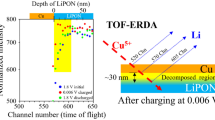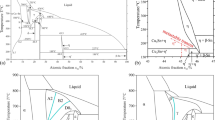Abstract
Finite fossil-fuel supplies, nuclear waste and global warming linked to CO2 emissions have made the development of alternative/‘green’ methods of energy production, conversion and storage popular topics in today’s energy-conscious society. These crucial environmental issues, together with the rapid advance and eagerness from the electric automotive industry have combined to make the development of radically improved energy storage systems a worldwide imperative. CuMg2 has an orthorhombic crystal structure and does not form a hydride: it reacts reversibly with hydrogen to produce Cu2Mg and MgH2. However, CuLi x Mg2−x (x = 0.08) has a hexagonal crystal structure, just like NiMg2, a compound known for its hydrogen storage properties. NiMg2 absorbs up to 3.6 wt% of H. Our studies showed that not only CuLi x Mg2−x absorbs a considerable amount of hydrogen, but also starts releasing it at a temperature in the range of 40–130 °C. In order to determine the properties of the hydrogenated CuLi x Mg2−x , absorption–desorption, Differential scanning calorimeter and thermo-gravimetric experiments were performed. Neutron spectra were collected to elucidate the behavior of hydrogen in the Li-doped CuMg2 intermetallic. Using DFT calculations we were able to determine the best value for x in CuLi x Mg2−x and compare different possible structures for the CuLi x Mg2−x hydride.







Similar content being viewed by others
References
Yang K, An JJ, Chen S. Influence of additives on the thermal behavior of nickel/metal hydride battery. J Therm Anal Calorim. 2010;102:953–9.
Fang KZ, Mu DB, Chen S, Wu F, Zeng XJ. Thermal behavior of nickel–metal hydride battery during charging at a wide range of ambient temperatures. Therm Anal Calorim. 2011;105:383–8.
Reilly JJ, Wiswall RW. The reaction of hydrogen with alloys of magnesium and copper. Inorg Chem. 1969;6(12):2220–3.
Braga MH, Ferreira J, Malheiros LF. A ternary phase in Cu–Li–Mg system. J Alloy Comp. 2007;436:278–84.
Hewat P. (2007) Inorganic Crystal Structure Database. 156880.
Schlapbach L, Zuttel A. Hydrogen-storage materials for mobile applications. Nature. 2001;414:353–8.
Braga MH, Ferreira J, Malheiros LF, Hamalainen M. HT-XRD on the study of Cu–Li–Mg Z. Kristallog suppl. 2007;26:299–304.
Orimo S, Nakamori Y, Eliseo JR, Zuttel A, Jensen CM. Complex hydrides for hydrogen storage. Chem Rev. 2007;107:4111–32.
Reilly J, Wiswall R. The reaction of hydrogen with alloys of magnesium and nickel and the formation of Mg2NiH4. Inorg Chem. 1968;7(11):2254–6.
Braga MH, Malheiros LF. WO2007046017.dp.
Match software, http://www.crystalimpact.com/match/Default.htm, Accessed 31 Aug 2011.
de Wolff PM, Visser JW. Absolute Intensities. Report 641.109. Technisch Physische Dienst, Delft, Netherlands. Reprinted Powder Diffract. 1988;3:202.
Braga MH, Acatrinei A, Hartl M, Vogel S, Proffen Th, Daemen L. New promising hydride based on the Cu–Li–Mg system. J Phys Conf Ser. 2010;251:012040.
Sandrock GD, Thomas G. IEA DOE SNL On-line Hydride Database. http://hydepark.ca.sandia.gov. Accessed 2009.
Andreasen A. Hydrogen storage materials with focus on main group I-II elements. PhD thesis. ISBN 87-550-3498-5; 2005.
Mueller WM, Blackledge JP, Libowitz GG, editors. Metal hydrides. London: Academic Press Inc; 1968.
Yvon K, Renaudin G. Hydrides: solid state transition metal complexes. Encyclopaedia of Inorganic Chemistry, 2006.
Parker SF, Jayasooriya UA, Sprunt JC, Bortz M, Yvon K. Inelastic neutron scattering, IR and Raman spectroscopic studies of Mg2CoH5 and Mg2CoD5. J Chem Soc Farad Trans. 1998;94(17):2595–9.
Schimmel HG, Johnson MR, Kearley GJ, Ramirez-Cuesta AJ, Huot J, Mulder FM. The vibrational spectrum of magnesium hydride from inelastic neutron scattering and density functional theory. Mater Sci Eng B. 2004;108:38–41.
Patah A, Takasaki A, Szmyd JS. The Effect of Cr2O3/ZnO on hydrogen desorption properties of MgH2. Mater Res Soc Symp Proc. 2009:1148-PP03-38.
Balasooriya NWB. Poinsignon Ch. Preparation and characteristics of ball milled MgH2 + M (M = Fe, FeF3 and VF3) nanocomposites for hydrogen storage. Solid state ionics advanced materials for emerging technologies. Singapore: World scientific publishing Co. Pte. Ltd 2006. p 220–7.
Wu CZ, Wang P, Yao X, Liu C, Chen DM, Lu GQ, Cheng HM. Hydrogen storage properties of MgH2/SWNT composite prepared by ball milling. J Alloys Comp. 2006;420(1–2):278–82.
Montone A, Grbovic J, Stamenkovic Lj, Fiorini AL, Pasquini L, Bonetti E, Antisari MV. Desorption Behaviour in Nanostructured MgH2-Co. Mat Sci Forum. 2008;518:79–84.
Lillo-Rodenas MA, Aguey-Zinsou KF, Cazorla-Amoros D, Linares-Solano A, Guo ZX. Effects of carbon-supported nickel catalysts on MgH2 decomposition. J Phys Chem C. 2008;112:5984–92.
Tessier P, Akiba E. Decomposition of nickel-doped magnesium hydride prepared by reactive mechanical alloying. J Alloys Comp. 2000;302:215–7.
Milovanovic S, Matovic L, Drvendzija M, Novakovic JG. Hydrogen storage properties of MgH2-diatomite composites obtained by high-energy ball milling. J Micros. 2008;232(3):522–5.
Deledda S, Borissova A, Poinsignon C, Botta WJ, Dornheim M, Klassen T. H-sorption in MgH2 nanocomposites containing Fe or Ni with fluorine. J Alloys Comp. 2005;404–406:409–12.
Shao H, Wang Y, Xu H, Li X. Preparation and hydrogen storage properties of nanostructured Mg2Cu alloy. J Solid State Chem. 2005;178:2211–7.
Blochl PE. Projector augmented-wave method. Phys Rev B. 1994;50:17953–79.
Kresse G, Furthmüller J. Efficient iterative schemes for ab initio total-energy calculations using a plane-wave basis set. J. Phys Rev B. 1996;54:11169–86.
Kresse G, Furthmüller J. Efficient iterative schemes for ab initio total-energy calculations using a plane-wave basis set. Comp Mat Sci. 1996;6:1.
Kresse G, Joubert D. From ultrasoft pseudopotentials to the projector augmented-wave method. Phys Rev B. 1999;59:1758–75.
Perdew JP, Burke K, Ernzerhof M. Generalized Gradient Approximation Made Simple. Phys Rev Lett. 1996;77(18):3865–8.
Braga MH, Ferreira JJA, Siewenie J, Proffen Th, Vogel SC, Daemen LL. Neutron powder diffraction and first-principles computational studies of CuLixMg2-x (x ≅ 0.08), CuMg2, and Cu2Mg. J Sol. Stat Chem. 2010;183:10–9.
Acknowledgements
The authors would like to acknowledge Portuguese Science Foundation, FCT, for the project (PTDC/CTM/099461/2008 and FCOMP-01-0124-FEDER-009369). This work has benefited from the use of neutron scattering instrument FDS at the Lujan Center at Los Alamos Neutron Science Center, funded by DOE Office of Basic Energy Sciences. Los Alamos National Laboratory is operated by Los Alamos National Security LLC under DOE Contract DE-AC52-06NA25396.
Author information
Authors and Affiliations
Corresponding author
Rights and permissions
About this article
Cite this article
Braga, M.H., Ferreira, J.A. & Wolverton, M.J. Study of the Cu–Li–Mg–H system by thermal analysis. J Therm Anal Calorim 108, 733–739 (2012). https://doi.org/10.1007/s10973-011-2126-0
Published:
Issue Date:
DOI: https://doi.org/10.1007/s10973-011-2126-0




